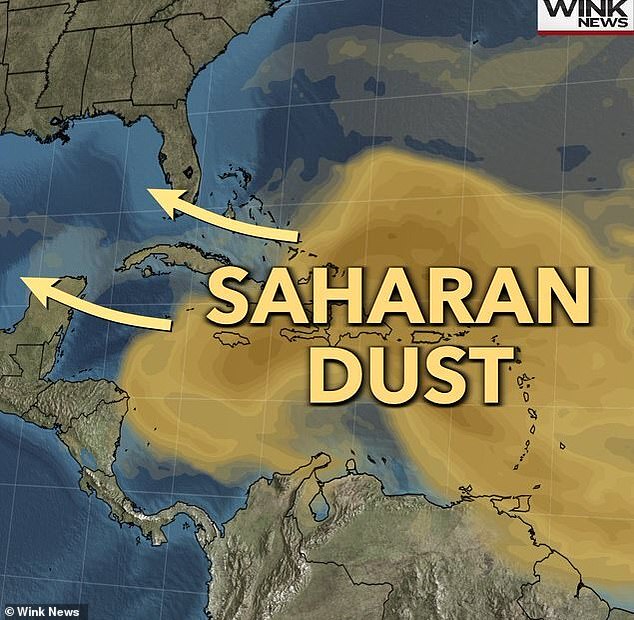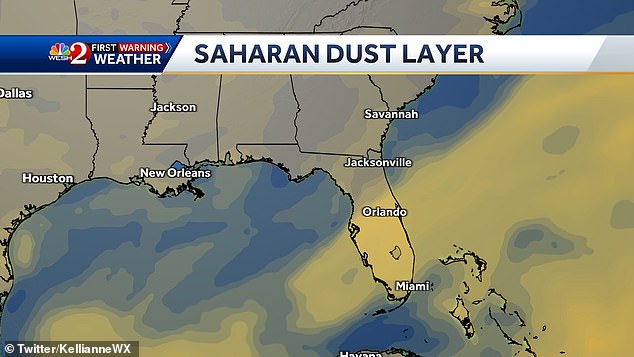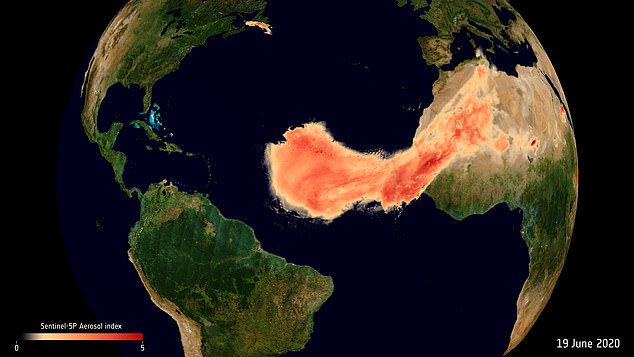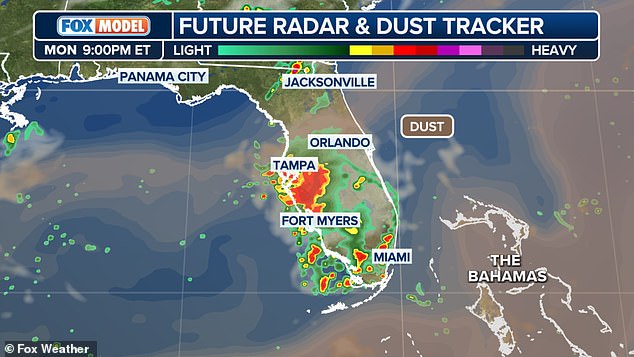Forecasters have warned Florida to brace for “dirty rain” as a plume of Saharan dust envelops the state this weekend.
Thunderstorms are forecast in the Sunshine State on Saturday and Sunday, combining with the dust particles to leave a film on anything the droplets touch.
While the polluted fallout and plumes are mostly harmless, experts have urged people with respiratory problems to wear face coverings outdoors.
The massive plume was formed by strong winds that carried tiny particles of sand and minerals from the surface of the Sahara, and the current wave is the largest of the season.
Forecasters have warned Florida to brace for “dirty rain” as a plume of Saharan dust envelops the state this weekend.
FOX Weather meteorologist Britta Merwin said: ‘You have this creepy layer of gross stuff on your car; you think it’s not pollen, it’s dust.
‘Be careful of the dust that accumulates. Also, if it falls on the air conditioner, it can clog it, so it’s a good idea to spray it with water.’
Every summer, winds carry large amounts of dust particles from the hot, dry desert of North Africa westward across the Atlantic.
Large amounts of dust particles from the African desert are blown into the dry air by thunderstorms and strong winds near the ground.
The dust can then float for days or weeks, depending on how dry, fast-moving and turbulent the air masses become.
The Saharan dust plume traveled more than 4,000 miles from Africa over the past month or so, passing over central Florida on Wednesday.
However, the dust is expected to persist through the weekend, when thunderstorms are forecast.
And the combination of rain and dust will create “muddy patches on surfaces,” according to FOX Weather.
Saharan dust hit Florida’s eastern coast earlier this month, improving sunrises and sunsets by scattering more light across the sky.
While the plume of dust may be bothersome to Americans, it’s a good sign in the midst of hurricane season.
The National Hurricane Center reported that active tropical waves are forming off the coast of Africa, but dust particles absorb sunlight and act as air stabilizers to reduce tropical waves and prevent cyclones from forming.

Every summer, winds carry large amounts of dust particles from the hot, dry desert of North Africa westward across the Atlantic.

Thunderstorms are forecast in the Sunshine State on Saturday and Sunday, combining with the dust particles to leave a film on anything the droplets touch.
This year is projected to be one of the most active on record, with 24 named storms, 11 of which are expected to become hurricanes.
Saharan dust forms over the African desert each spring, spreading one to three miles above the surface and reaching thousands of miles in length.
Outbreaks typically occur every three to five days until they peak between mid-June and mid-August, often bringing colorful, hazy sunsets to the Florida coast characterized by their yellow and red hues.
As the dust travels toward the United States, a pocket of dry air forms thousands of feet above sea level, which will bring drier air and warmer conditions, suppressing tropical developments like hurricanes by removing the moisture they need to form.
They also create strong winds in the upper reaches of the dust plume, which can reach up to 60 miles per hour and tear off the cloud tops of any tropical hurricane.

The 2020 plume was the largest on record, earning it the name “Godzilla.” Data showed it had 60 to 70 percent more dust than average, making it the dustiest event since records began about 20 years ago.
The 2020 plume was the largest on record and was named “Godzilla.”
The data showed there was 60 to 70 percent more dust than average, making it the dustiest event since records began about 20 years ago.
While small particles can trigger air quality alerts and irritate those with respiratory problems, dust can also enhance sunsets, suppress the development of tropical storms and play an important role in our ecosystem.
Dust is an important source of nutrients for phytoplankton – microscopic marine plants that float on or near the ocean surface.
Some of the minerals in the dust fall into the ocean, causing phytoplankton blooms to form on the ocean surface, which in turn provide food for other marine life.
Dust is also essential for life in the Amazon, as it replenishes nutrients in rainforest soils that would otherwise be depleted by frequent rainfall.


